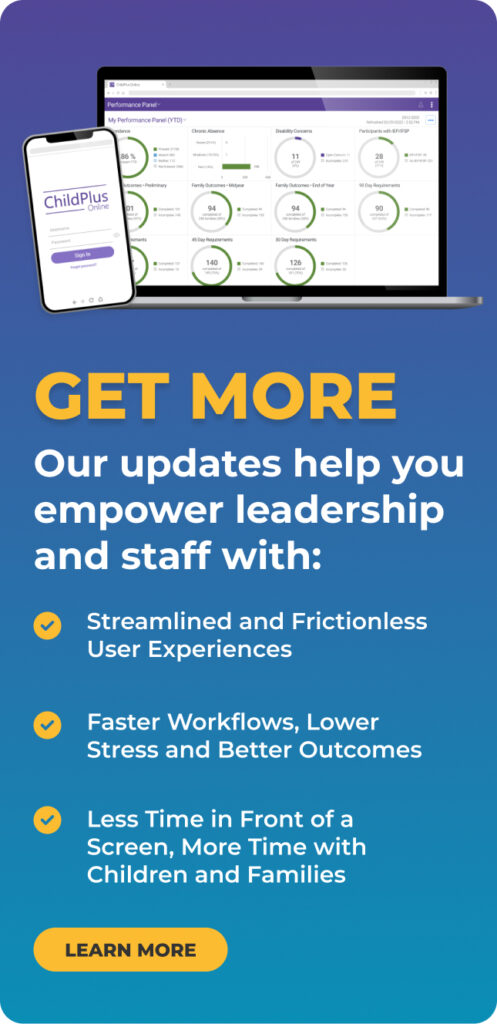
Use Child Outcomes to Guide Professional Development
DRDP Data – It’s not just about Children!
As you develop your annual training plan for educators, use your DRDP data to make informed decisions in the following 3 categories of professional development:
- FIDELITY
As an evidence-based assessment, the validity and reliability of DRDP data is dependent on your staff’s comprehension of the domains and measures as well as what the related child behaviors actually look like in action. Use report 5004 to analyze your teams’ confidence in implementing the DRDP.- 5004 – Observation Counts by Child
- Run this report in summary mode for all classrooms. What do you notice? Do some measures have many more observations collected than others? Use the data and questions like the following to recognize training needs:
- Do staff understand the measures?
- Are staff providing enough activities to generate related behaviors?
- Are Head Start educators capturing ample observations specific to English Language Learners and children on IEP’s?
- Run this report in summary mode for all classrooms. What do you notice? Do some measures have many more observations collected than others? Use the data and questions like the following to recognize training needs:
- 5004 – Observation Counts by Child
- QUALITY
Documentation of observations is THE source for assessing children’s progress and determining the effectiveness of instruction. Without an objective viewpoint and sufficient detail, decisions made about children’s performance and the next steps in lesson planning may miss the mark. Use report 5023 to evaluate the quality of information your staff use in decision-making.- 5023 – DRDP Portfolios
- Use samples of observations from this report (with staff and children’s names redacted) to demonstrate the characteristics of high-quality observations (the setting, what was seen and heard, who was involved). In small groups, invite staff to review additional redacted samples and identify which criteria are included and/or missing and determine how they would improve them. Lastly, ask staff to examine 1 or more of their own observations and revise them to meet quality standards.
- Use samples of observations from this report (with staff and children’s names redacted) to demonstrate the characteristics of high-quality observations (the setting, what was seen and heard, who was involved). In small groups, invite staff to review additional redacted samples and identify which criteria are included and/or missing and determine how they would improve them. Lastly, ask staff to examine 1 or more of their own observations and revise them to meet quality standards.
- 5023 – DRDP Portfolios
- INSTRUCTION
Educators need a broad array of knowledge and skill to meet the demands of teaching their young learners. Use reports 5042 and 5040 to help identify trends and patterns across your program as well as within specific subgroups so your staff are well-equipped to provide quality experiences and interactions for all children.- 5042 – Group Progress Report
- Filter this report to include your choice of subgroups. Are there significant differences in the results? Could the contrast between 3 and 4 year-old outcomes suggest a need for training on developmentally appropriate practices? Does the disparity in outcomes for boys and girls signal a need for focused education on the uniqueness of each learner? Do the lower outcomes for children with disabilities reflect the need for diagnosis-specific strategy instruction for staff?
- Filter this report to include your choice of subgroups. Are there significant differences in the results? Could the contrast between 3 and 4 year-old outcomes suggest a need for training on developmentally appropriate practices? Does the disparity in outcomes for boys and girls signal a need for focused education on the uniqueness of each learner? Do the lower outcomes for children with disabilities reflect the need for diagnosis-specific strategy instruction for staff?
- 5042 and 5040 – Group Detail Report
- Use the median score lines in the 5042 to determine which domains require examination. Deepen your understanding of the outcomes in those domains by reviewing their measures in the 5040. Which measures need attention? Dig even deeper into the 5040 and identify staff with demonstrated success in the pinpointed measures. Invite these staff to assist in training their peers through the sharing and creation of lesson plans and activities focused on the identified measures.
- 5042 – Group Progress Report

Comments are closed.